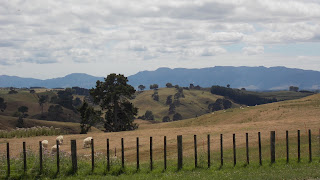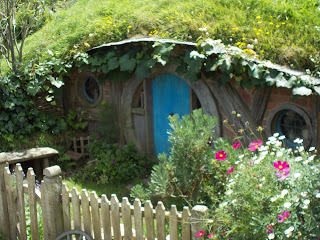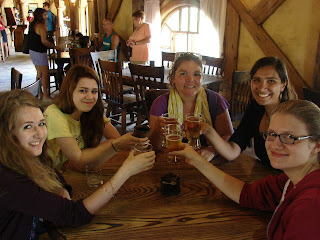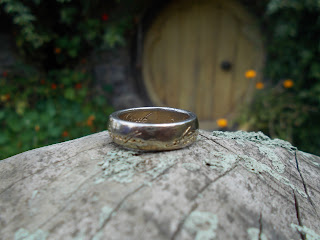I have been so bad in keeping this updated, I apologize!
Since my last post about my first day-trip around Auckland to beaches and
through forests, I have done a lot. The day to day living in Auckland includes classwork
and exploring, as well as experimenting in the kitchen. It is the summer
session of classes at the University of Auckland, and I am taking one course,
Geography 207 during the summer here in addition to a sociology course about
New Zealand Politics, Society, and Maori Culture that all of us in the BU
program take. The geography class is a field class where most of our learning
took place on a weeklong trip we took around Northland. Here is a map of the
North Island and Northland to give you an idea of where I went.


The course has about 60 students, and we were divided into 7
different vans with approximately 8 students in each van. The vans developed
names and rivalries throughout the trip and were decked out with tape on the
windows. The van names were: NirVANah, Roman VANdals, Pirates of the
CarribeVAN, GeoDudes, Gretals's Petals, Krazy Horses and my van, It's Raining
Men and Miles (We were a van randomly of all girls and one guy named Miles). In
addition, Nick, one of the lecturers drove a separate "Kai Waka" as
we dubbed it (Kai is food in Te Reo (the Maori language) and Waka is canoe) or
food van.
.JPG)

On the trip, we drove up the east coast of Northland and
circled back down along the west coast. The east coast is more developed and
touristy while the west coast is more rugged and wild. This is due to many
interacting factors involving social history as well as geomorphology. On the
east coast we stopped at two different beaches where we took some beach
measurements including wave height, dune height, dune vegetation, and beach
angle. After, we were allowed to just hang out on the beach and have some
lunch. These were the most beautiful beaches I've been to/seen. They were
called Lang's Beach, and Matai Bay, but Matai Bay in particular was gorgeous.
 |
| Lang's Beach | |
 |
| Lang's Beach |
 |
| Lang's Beach |
 |
| Lunch at Matai Bay |
The first night we stayed at hostels in the Bay of Islands
town of Paihia. We had pizza for dinner where the seagulls would steal your
food if you didn't guard your plate carefully. We didn't stay here long, the
next day we had breakfast on the beach and did a field exercise analyzing the
tourism of the area then headed out to the town of Kawakawa which is famous for
its public toilets which were designed by the artist Hundertwasser.
 |
| Evening in Paihia |
 |
| Devilish seagull at dinner |
 |
| Down the street from our hostel in Paihia |
 |
| I didn't get a good picture of the toilets so here's one courtesy of Google |
|
 |
| And another :-) |
Joe, the main geography lecturer/trip coordinator is from
here and told us a story about how Hundertwasser was friends with his
grandfather and would often stay with them on his grandfather's farm. He told
us how one summer he was painting Hundertwasser's boat and spent so long using
tape to try and make a straight line when Hundertwasser came over and asked why
he was doing that, then said "Straight lines lead to Hell" and walked
away. The toilets are really funky with glass bottles inlaid in cement and wavy
mosaic everywhere. No straight lines can be found anywhere, even the floor is
wavy. The way Joe talked about Hundertwasser reminds me a bit of my Uncle
Stephen, a crazy creative personality. The second night we camped out at Aroha
Island, a Kiwi Sanctuary. After a barbeque, we went out with red cellophane
tinted flashlights and looked for kiwis. I sat for an hour silently hoping to
see one and a lot of people did but I only managed to hear them calling to each
other. Oh well, it was still a great time! The rocky beach on the island was so
peaceful and I spent some time doing origami while there.
The third day we went to Ngawha Springs, which has natural hot springs you can go in. The smell of sulfur didn't dissaude many from testing how hot they could stand.
The third night was my favorite night. We crossed over to
the west coast full of windy dirt roads and stayed on a marae, which is a Maori
ceremonial community area. One of our van drivers, Geremy is Maori from this
particular Motuti Marae and we went through an official welcome that involved
an exchange of oratory in Te Reo and also an exchange of songs. Every day
leading up to this, all 60 of us practiced learning two Maori waiatas or songs
to sing to the people at Motuti Marae, now they are stuck in my head! While on
the marae, we ate a huge feast of delicious food and met some very heartwarming
people. We all slept on mattresses in one big room and before sleeping we all
individually stood up and introduced ourselves and said a little about our
families and ourselves. It was really special hearing everyone talk.
 |
| Motuti Marae |
 |
| During the day... |
 |
| ...and at night! |
 |
| I had fun in the mattress room at the marae |
The next day we took a ferry over to Hokianga Harbor which has
enormous sand dunes. The little town of Opononi was famous for one summer in
1956 when a lone dolphin Opo would play with people in the harbor.
 |
| Sand Dunes across the water |
 |
| Hokianga Harbor |
We checked out 90
mile beach (which is actually 90 km) and then hopped into the vans and headed
out to the big kauri preservation forests of Waipou and Trounsen. Here we heard
a talk from the closest I've seen to a hobbit thus far, Stephen King, a
conservationist who runs barefoot through the forests and is replanting kauri
for future generations. We also got to see 2000 year old Tane Mahuta, the
largest kauri tree in New Zealand.
 |
| Tane Mahuta |
For the last night we stayed in a hotel in
Dargaville which was pretty much a ghost town. Apparently the queen has stayed
in the hotel we were in, well don't I feel fancy! We had a buffet dinner and the lecturers gave out silly prizes. The last day we drove back to
Auckland where I promptly collapsed on my bed and slept for what felt like a
week.
It was a really great trip! I met a lot of new Kiwi friends
and in the process learned some stuff (imagine that!). Northland is considered
the poorest region of New Zealand and often overlooked, but it had a lot to
offer. I definitely made some wonderful memories.





















.JPG)





















